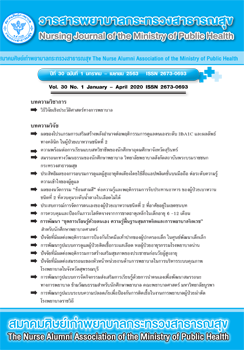Development of a Safety System Model to Prevent Infection in Operating Theatre Nursing Department, Rajavithi Hospital
Main Article Content
Abstract
This research aimed to develop a safety system model to prevent infection in operating theatre nursing department at Rajavithi Hospital using a mixed-method design. The study composed of 3 phases: Phase 1: study of the current situation; Phases 2: model development; Phases 3: evaluation of the outcomes of the model. Data were collected using a literature review and evidenced-based practice, a focus group, a record, observations, and questionnaires. Qualitative data were analyzed using content analysis, while quantitative data were analyzed using frequency, percentage, mean, standard deviation and paired t-tests. The results found that the safety system model to prevent infection in the operating theatre nursing department composed of 3 phases. Phase 1: Pre-operation, which consisted of 5 components, including a pre-operative care at the ward, a patient visit before the operation, preparation of the operating room, preparation of personnel for the operation, and preparation of patients when they come to the operating rooms. Phase 2: Intra-operation, which consisted of 1 component which was nursing care during the operation. Phase 3: Post-operation, which consisted of 2 components, namely, the post-operative period in the operation room and post-operative period in the ward. After implementing the model, 99.20% of personnel were able to follow the model. There were no incidents of surgical site infection and no incidents of injury to personnel. Patients who received nursing care using the model reported a moderate level of satisfaction (Mean=35.79) at the first time of implementation, and a high level of satisfaction (Mean=37.93) at the second time of implementation. Personnel reported a moderate level of satisfaction for using the model, both at the first and second time of implementation. However, satisfaction of the second implementation was significantly higher than the first implementation at p=.01. In conclusion, the model was tested to be effective to reduce surgical site infections and injury to personnel.
Article Details
บทความและรายงานวิจัยในวารสารพยาบาลกระทรวงสาธารณสุข เป็นความคิดเห็นของ ผู้เขียน มิใช่ของคณะผู้จัดทำ และมิใช่ความรับผิดชอบของสมาคมศิษย์เก่าพยาบาลกระทรวงสาธารณสุข ซึ่งสามารถนำไปอ้างอิงได้
References
2. Anderson DJ, Podgorny K, Berrios-Torres SL, Bratzler DW, Dellinger EP, Green L, et.al. Strategies to prevent surgical site infection in acute care hospital: 2014 update. Infection Control and Hospital Epidemiology 2014;35:605-627.
3. Kasatpibal N, Norgaad M, Jamulitrat S.Improving surveillance system and surgical site infection rates through a network:a pilot study from Thailand. Clinical Epidemiology 2009;1: 67-74. (in Thai).
4. Suwannakeeree W, Payaprom Y. Prevention of surgical site infection. Journal of Nursing Science Chulalongkorn University 2017;29(2):15-28. (in Thai).
5. Institute for Hospital Quality Assurance (Public organization). Safety targets of public health personnel in Thailand 2018. Nonthaburi: Famous and Successful; 2018. (in Thai).
6. Surgical Nursing Report. Surgical nursing care group. Rajavithi Hospital; 2018. (in Thai).
7. Rajavithi Hospital. Operating theatre department. Report summary of surgical nursing. Bangkok; Rajavithi Hospital; 2018. (in Thai).
8. Deming, W.E. (1993). PDCA cycle a quality approach. Cambridge: MA MIT; 1993.
9. Royal College of Physicians Committee. Recommendations for making clinical practice guidelines. The Royal College of Physicians of Thailand 2001;18(6):36-47. (in Thai).
10. Medical Technology Research and Assessment Institute. Department of Medical Services. Appraisal of Guideline for Research & Evaluation II; AGREE II. Nonthaburi: Institute; 2013. (in Thai).
11. Best JW. Research in education. 2nd ed. Englewood Cliffs, New Jersey: Prentice–Hall; 2006.
12. World Health Organization. Global guidelines for the prevention of surgical site Infection. Geneva: WHO; 2016.
13. Bureau of Nursing, Department of Medical Services, Ministry of Public Health. Nursing standards in hospitals. 2nd update. Bangkok: Veterans Relief Organization; 2007.
14. Ruengsri N. The Development of supervision program for head nurses in empowering professional nurses at a tertiary level hospital in the medical service department under Bangkok metropolitan administration. Journal of Nursing, Siam University 2017;35:95-105. (in Thai).
15. YooSiri R, Aebsirisuk K, Narumitlert C, Chiwapat P. Nursing administration. Bangkok: The Thai Red Cross College of Nursing; 2008. (In Thai).
16. Suthisarn S. Supervision strategies for effective outcomes in nursing achievement. Songkhla: Relationship Typing; 2008. (In Thai).
17. Khamla A, Wongwatanarerk W, Chularee S, Chairanai C, Kaewta K.The Development of care model to prevent surgical site infection for patients undergoing coronary artery bypass graft using evidence-based practice. Journal of Nursing and Health Care 2017;35 (2):34-44. (in Thai).
18. Saengla L. Development of guidelines for nurses on needle stick and sharp injuries prevention in community hospital. Chiang Mai: Chiang Mai University; 2007. (in Thai).
19. Winaiphanich D, Junnoi N, Intasuwan D. The study of nursing in surgical patients at Uthai Thani Hospital. Journal of Nursing Division 2015;1:58-75. (in Thai).
20. Paiboonpalayoi B. The effects of participatory supervision program for head nurses on professional nurses’performances at a tertiary level hospital in the department of medical services under the Ministry of Public Health. Nakhon Pathom: Christian University; 2015. (in Thai).
21. Suphanpayap P, Suksadisai P, Ampon K. Developing a nursing supervision model of the nursing division in Phrapokklao Hospital. Journal of Nursing and Education 2013;1:12-26. (in Thai).
